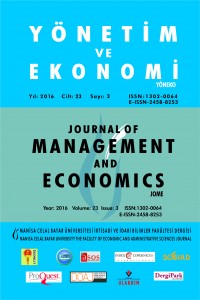Abstract
Bu çalışmanın ana amacı Chan vd. (2012) tarafından geliştirilen “Girişimcilik, Profesyonellik ve Liderlik (EPL)” ölçeğinin Türk öğrenciler için doğrulamasının yapılmasıdır. EPL ölçeği öğrencilerin girişimcilik, profesyonellik ve liderlik bileşenlerine olan arzularını motivasyon, etkinlik ve niyet bazında bağımsız olarak ölçmektedir. EPL ölçeği Kim Yin Chan’den izin alınarak uygulanmış ve anket sorularının cevapları, öğrenci bazında Kim Yin Chan’in vermiş olduğu değerlendirme tablosuna göre toplamsal olarak elde edilmiştir. Bu toplamsal puanlar tüm analizlerde kullanılmıştır. EPL kariyer isteği ölçeği “Motivasyon – Niyet – Etkinlik” olmak üzere üç temel faktörden oluşmaktadır. Bu temel faktörlerin “Girişimcilik – Profesyonellik – Liderlik” olmak üzere üçer alt faktörü vardır. EPL ölçeğinin betimsel analizi ve doğrulanması amacı ile anket Türkçe’ye çevrilerek Manisa Celal Bayar Üniversitesi Uygulamalı Bilimler Yüksekokulundaki 903 öğrenciye uygulanmış, iki aşamalı doğrulayıcı faktör analizi ile orijinal ölçeğin Türk öğrencilerine uyumuna bakılmış ve iyi uyum sağlayacak bir şekilde ölçeğin yeniden düzenlenmesi yapılmıştır.
References
- Barker, R. A. (2002). On the nature of Leadership. Lanham, MD: University Press of America.
- Chan, K.Y., Ho, M.H.R., Chernyshenko, O.S., Bedford, O., Uy, M.A., Gomulya, D., Sam, Y.L., Phan, W.M.J. (2012). Entrepreneurship, professionalism, leadership: A framework and measure for understanding boundaryless careers. Journal of Vocational Behavior, Vol:81, No:1, 73–88.
- Cogliser, C.C., Brigham, K.H. (2004). The intersection of leadership and entrepreneurship: Mutual lessons to be learned. The Leadership Quarterly, 15, 771–799.
- Downie, R. (1990). Professions and professionalism, Journal of Philosophy of Education, Vol:24, Issue 2, 147-159.
- Hambric, D.C., Mason, P. A., (1984). Upper Echelons: The Organization As A Reflection Of İts Top Managers. Academy of Management Review, Vol:9, No:2, 193-206.
- Hisrich, R. D., Peters, M. P. (1989). Entrepreneurship: Starting, Developing, and Managing a New Enterprise. Homewood, IL: BPI, Irwin.
- Kanter, R. M. (1989). Careers and the wealth of nations: A macro-perspective on the structure and implications of career forms. In M. Arthur, D. Hall, B. Lawrence (Eds.), Handbook of career theory (pp. 506–522). Cambridge, UK: Cambridge University Press.
- Khurana, R. (2001). Finding the right CEO: Why boards often make poor choices. MIT Sloan Management Review, Vol:43, No:1, 91-95.
- Marques, J., Dhiman, S. (Eds.). (2017). Leadership Today: Practices for Personal and Professional Performance. Springer.
- Onuoha G. (2007). Entrepreneurship. AIST International Journal, 10, s.20-32.
- Öner, M., Onay, M., Kocakoç, İ.D. (2016). Girişimcilik, Profesyonellik ve Liderlik Ölçeğinin CBÜ Uygulamalı Bilimler Yüksekokulu Öğrencileri Üzerinde İncelenmesi”, IMCOFE2016, International Multidisciplinary Congress Of Eurasia 2016, Odessa, 11-13 Temmuz. IMCOFE Proceedings Volume-2, 69-76. Rost, J. C. (1993). Leadership for the twenty-first century. Praeger, Westport, Connecticut, London, 1993.
- Sabuncuoğlu, Z. (2005). İnsan Kaynakları Yönetimi. Bursa, Alfa Yayınları.
- Taş, A., Çavuş, M.F. (2010). Türkiye’deki Profesyonel Yöneticiler Üzerine Bir inceleme: Nasıl Seçiliyorlar? Hangi Özellikleri Ön Plana Çıkıyor? Hangi Yetkilerle Donatılıyorlar? Çukurova Üniversitesi Sosyal Bilimler Enstitüsü Dergisi, Cilt 19, Sayı:1, 185-201.
- Yukl, G. (2002). Leadership in Organizations. Fifth Edition, New Jersey: Prentice Hall Inc.
Measuring Entrepreneurship, Professionalism and Leadership Career Aspiration of Students in Career Planning
Abstract
The main purpose of this study is to confirm EPL (Entrepreneurship, professionalism and leadership) scale, which is developed by Chan et.al. (2012) for Turkish students. EPL scale measures students’ tendencies towards these components based on their motivation, efficacy and intent. Scale is used by the consent of Kim Yin Chan and results of the surveys are computed in terms of sums of scores as told by the evaluation scheme given by Chan. These summed scores are used in all analyses. EPL scale is composed of three main factors, namely motivation, intent and efficacy. Each main factor has three sub-factors: Entrepreneurship, professionalism and leadership. By a survey study on 903 of Manisa Celal Bayar University students, original EPL scale is examined by second order confirmatory factor analysis (CFA) and re-designed to fit Turkish students.
References
- Barker, R. A. (2002). On the nature of Leadership. Lanham, MD: University Press of America.
- Chan, K.Y., Ho, M.H.R., Chernyshenko, O.S., Bedford, O., Uy, M.A., Gomulya, D., Sam, Y.L., Phan, W.M.J. (2012). Entrepreneurship, professionalism, leadership: A framework and measure for understanding boundaryless careers. Journal of Vocational Behavior, Vol:81, No:1, 73–88.
- Cogliser, C.C., Brigham, K.H. (2004). The intersection of leadership and entrepreneurship: Mutual lessons to be learned. The Leadership Quarterly, 15, 771–799.
- Downie, R. (1990). Professions and professionalism, Journal of Philosophy of Education, Vol:24, Issue 2, 147-159.
- Hambric, D.C., Mason, P. A., (1984). Upper Echelons: The Organization As A Reflection Of İts Top Managers. Academy of Management Review, Vol:9, No:2, 193-206.
- Hisrich, R. D., Peters, M. P. (1989). Entrepreneurship: Starting, Developing, and Managing a New Enterprise. Homewood, IL: BPI, Irwin.
- Kanter, R. M. (1989). Careers and the wealth of nations: A macro-perspective on the structure and implications of career forms. In M. Arthur, D. Hall, B. Lawrence (Eds.), Handbook of career theory (pp. 506–522). Cambridge, UK: Cambridge University Press.
- Khurana, R. (2001). Finding the right CEO: Why boards often make poor choices. MIT Sloan Management Review, Vol:43, No:1, 91-95.
- Marques, J., Dhiman, S. (Eds.). (2017). Leadership Today: Practices for Personal and Professional Performance. Springer.
- Onuoha G. (2007). Entrepreneurship. AIST International Journal, 10, s.20-32.
- Öner, M., Onay, M., Kocakoç, İ.D. (2016). Girişimcilik, Profesyonellik ve Liderlik Ölçeğinin CBÜ Uygulamalı Bilimler Yüksekokulu Öğrencileri Üzerinde İncelenmesi”, IMCOFE2016, International Multidisciplinary Congress Of Eurasia 2016, Odessa, 11-13 Temmuz. IMCOFE Proceedings Volume-2, 69-76. Rost, J. C. (1993). Leadership for the twenty-first century. Praeger, Westport, Connecticut, London, 1993.
- Sabuncuoğlu, Z. (2005). İnsan Kaynakları Yönetimi. Bursa, Alfa Yayınları.
- Taş, A., Çavuş, M.F. (2010). Türkiye’deki Profesyonel Yöneticiler Üzerine Bir inceleme: Nasıl Seçiliyorlar? Hangi Özellikleri Ön Plana Çıkıyor? Hangi Yetkilerle Donatılıyorlar? Çukurova Üniversitesi Sosyal Bilimler Enstitüsü Dergisi, Cilt 19, Sayı:1, 185-201.
- Yukl, G. (2002). Leadership in Organizations. Fifth Edition, New Jersey: Prentice Hall Inc.
Details
| Journal Section | Articles |
|---|---|
| Authors | |
| Publication Date | December 29, 2016 |
| Published in Issue | Year 2016 Volume: 23 Issue: 3 |


